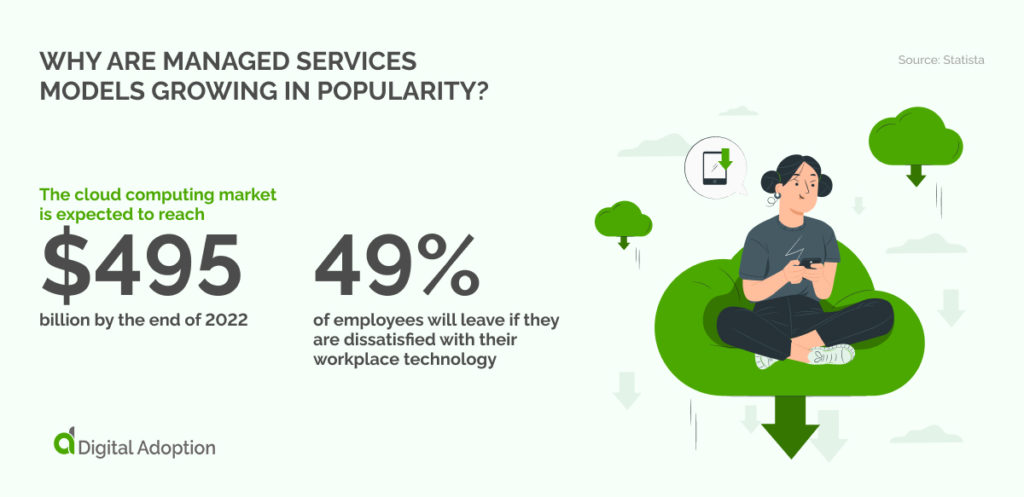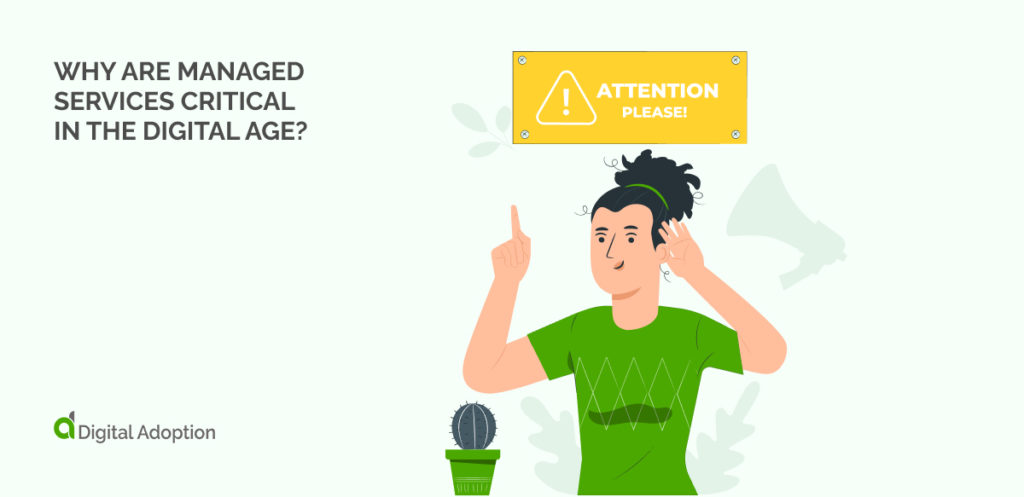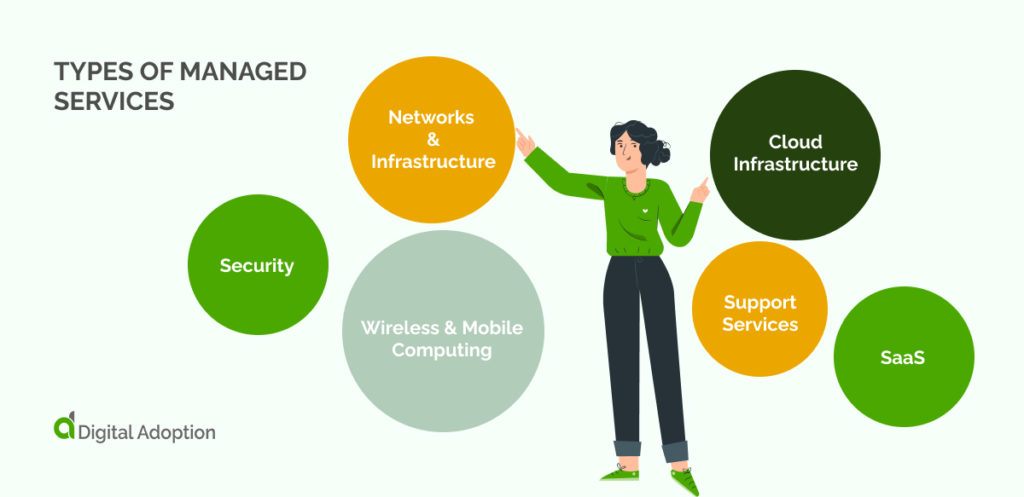Two critical questions confront organizations today. What’s the best way to be digitally agile? And how can we outsource IT services to a third party to allow our internal IT teams to use their technical expertise on more complex tasks? Managed services are the answer to both these questions.
But what are ‘managed services’? What types of managed services exist today? And what are the incentives for and benefits of implementing managed services for SMEs and large enterprises in the context of digital transformation? It’s best to begin to explore these questions by defining what we mean by managed services.
- What Are Managed Services?
- Why Are Managed Services Models Growing In Popularity?
- The Impact Of Managed Services On IT
- Why Are Managed Services Critical In The Digital Age?
- Types Of Managed Services
- How Do Managed Service Providers Impact Digital Transformation?
- The Future Of Managed Services
- Managed Services Make Agile Organizations
What Are Managed Services?
Expectations from customers are one of the most significant components of the rate of technology disruption in 2022. These tougher expectations make it difficult for organizations to manage digital agility amongst core tasks using current operating models. Each managed service provider offers a cost-effective route to digital transformation, promoting agility and enabling IT staff to design and improve new IT systems specific to a company’s needs.
Examples of managed services include technology solutions such as:-
- The cloud
- Managed hosting
- Desktop as a Service (DaaS)
- Software as a Service (SaaS)
- 24/7 access to third-party IT services providers
Managed services have many benefits, causing them to explode in popularity in the past decade.
Why Are Managed Services Models Growing In Popularity?

Before the global pandemic of 2020, digital disruption and the need for constant technological innovation were already a continuous demand on organizations. The pandemic and the pressing need to transform the customer experience in a changing retail market increased this need via video-conferencing and other technologies to enable remote working, forcing companies to accelerate digital transformation strategies. According to Statista, the cloud computing market is expected to reach $495 billion by the end of 2022.
However, the main reason that managed services are popular is the gap between reality and the need for the most up-to-date technology solutions. Managed services help address deficiencies caused by this gap by providing low-cost, innovative services that allow organizations to remain resilient against competitors in a way only a managed service provider can offer.
Employees often cite a lack of appropriate and up-to-date technologies as a reason for leaving their organization, so managed services can also improve employee retention. Adobe conducted an employee survey which found that 49% of employees will leave if they are dissatisfied with their workplace technology.
The Impact Of Managed Services On IT
The impact of utilizing managed services in IT is far-reaching for employee satisfaction, output, and the expenditure budget. Companies using third-party services significantly reduce their operating expenses compared to on-premise alternatives by moving maintenance and employee support to an external provider. Other benefits save time, such as the automatic updates of SaaS, whereas, before this, internal IT staff would have to update each system manually.
The other impact of managed services is that they eliminate overlooked expenses. When an organization pays the monthly fee, they see exactly what they are getting and how much it costs. This payment procedure is perfect for smaller companies with fixed budgets and larger enterprises with constant growth plans.
Why Are Managed Services Critical In The Digital Age?

Managed services are critical in the digital age as they fulfill roles in three key areas:-
- IT top talent retention
- Privacy and cybersecurity concerns
- Aligning IT processes with business goals
Managed services address many of the challenges of digital transformations to hybrid working. IT talent is more difficult to recruit now than ever due to a lack of technical skillsets, and retaining the staff is difficult due to this shortage and staff moving to competitors. When organizations choose a 24/7 IT support service, providers eliminate these problems.
Another problem with hybrid working is security when staff is working from home. A robust cybersecurity SaaS package protects against threats at low monthly fees that are scalable as staffing numbers change. And finally, managed services can help align IT processes with an organization’s goals more efficiently.
Types Of Managed Services

Many types of managed services exist to fit all business needs. The first involves networks and infrastructure to manage outcome success more effectively.
Networks & Infrastructure
Managed services providers can offer many services to manage networks and infrastructure. Deploying the network and infrastructure managed service reduces the time spent setting up and maintaining these systems for internal IT staff.
Cutting out expenses for Wide Area Networks (WAN), Local Area Networks (LAN), managed gateways, and automated network support also reduces gross capital expenditure while giving a service delivered by external staff with deep industry expertise.
Security
A managed service provider offers security options to reduce malware and ransomware attacks and theft of sensitive information using three tools and methods:-
Application compatibility
Application compatibility ensures that all software and hardware are compatible with each other. This action saves time and reduces investment wastage.
Anti-malware software
Anti-malware software is essential to prevent unauthorized hacks and theft of sensitive information about customers or staff.
Maintenance and patch updates
Service providers update security software to the current version daily to ensure maximum protection to reduce theft or unauthorized access.
When managed service providers maintain these services, organizations save financial and time resources avoiding data loss and acting within legal frameworks to protect data. However, when choosing a managed security service, organizations should be aware of the security dangers of a third party being responsible for the data. Providers store it on the cloud compared to on-premise, where the company stores the information on internal office servers in locked rooms.
Support Services
Organizations reduce administrative waste when they utilize IT support services. The innate complexity of the emerging technology stack used by many organizations facilitates increasing support requirements, and the 24/7 services providers enable access to specialized advice anytime.
Support services cover many support ranges, remotely managing hardware to software and from protocols and programs to prompts. Reducing employee downtime can increase employee experience and reduce financial waste.
SaaS
Software as a Service (Saas) providers offers businesses the option to use the software on a flexible, monthly, or annual payment scheme. Service providers can modify and configure the software to the organization’s needs.
The most significant advantage of SaaS is that it is updated, upgraded, and patched remotely by the services provider, making the software perform optimally and saving the IT team time.
Wireless & Mobile Computing
Wireless and mobile computing services offer similar features to hosting and storage, but the wireless attribute provides many advantages over investing in large amounts of wired hardware.
Integrated wireless connectivity solutions via a managed service allow greater flexibility as staff move between devices. This benefit is the most significant when staff talks through a new product with a customer. With wireless devices, salespeople can showcase the product to the customer on a wireless project using input from a mobile device, then allow them to interact with a gamified version of the product on a tablet.
Cloud Infrastructure
A managed cloud infrastructure service involves the provider managing operating systems, storage, networks, and computing needs. The service provider can also include platforms, databases, and tools that can help streamline the business processes involved in the cloud infrastructure.
Organizations save time when they adopt a cloud infrastructure service, as the staff does not need to learn how to install and implement it. Staff can use such services within hours of paying the monthly fees. Using this service allows companies to prioritize core business tasks.
How Do Managed Service Providers Impact Digital Transformation?
Digital transformation is a term businesses have used for decades, but the global pandemic led to increasing pressure to utilize the digital transformation business model. Managed service providers fulfill digital transformation needs by providing new opportunities via the cloud and other managed services.
But digital transformation is more than technology adoption and improving business processes. A true digital transformation strategy is the act of an organization reconceptualizing an entire approach to business. This process involves a company using bold moves to reassess how they reach their business solutions to improve performance and increase agility.
The digital transformation managed services model is essential for any plan to improve agility, and the process begins with embracing an open-minded approach which became prominent in the pandemic. Companies need to maintain this open-minded attitude toward new investments and strategies such as the managed services model to allow digital transformation managed services to become integrated within core business functions.
Companies must review their approach to capital expenditure to free up the capital to invest in new technologies. Moving resource-heavy functions such as risk compliance, finance, and tax to the managed services model means that the fees for services are scalable, and companies pay fees each month as services are required. This flexible, rolling payment structure eliminates upfront costs, allowing investment in other areas for growth and innovation to boost resilience.
Innovation leads to agility by generating confidence in an organization. The most effective way to promote innovation is using managed digital transformation services to give expert knowledge and the best analytics to drive the most effective strategic changes. This process leads to digital transformation success and optimized business outcomes.
The big difference between digital innovation and digital transformation is that transformation is on a larger scale, in scope and approach. Transformation encompasses much thought into why companies invest in specific technologies and what purpose they will fulfill for a company.
The managed services model fits perfectly into this approach because of its modular nature. Organizations can add or remove software modules when their needs change to increase agility continuously. This structure allows several business benefits, enabling companies to choose the required service features when they have established their specific needs.
The Future Of Managed Services

The future of managed services will likely involve many emerging technologies such as automation, Artificial Intelligence (AI), and machine learning to optimize business processes. The future will likely increase the modular aspect of services and make software easier to design for specific business needs.
Managed Services Make Agile Organizations
Managed services are more popular now than ever and will continue to grow as demand increases in the industry. Business leaders and companies begin to focus on managed services more as the need for innovation and agility increases with the staggering rate of technological progress as part of digital transformation strategies.
All transformation strategies across the marketplace will integrate managed services into efforts to transform businesses into rapidly changing, agile enterprises. Customer expectations will continue to drive the new trends of managed service providers in the future of transformation. Current business models will become obsolete, and managed services will dominate as the leading solutions to enable technology services.




![18 Examples of AI in Finance [2025]](https://www.digital-adoption.com/wp-content/uploads/2025/06/18-Examples-of-AI-in-Finance-2025-300x146.jpg)
![14 Examples of AI in Manufacturing [2025]](https://www.digital-adoption.com/wp-content/uploads/2025/06/14-Examples-of-AI-in-Manufacturing-2025-300x146.jpg)
![29 Examples of AI in Education [2025]](https://www.digital-adoption.com/wp-content/uploads/2025/06/29-Examples-of-AI-in-Education-2025-300x146.jpg)
![15 Examples of AI in Retail [2025]](https://www.digital-adoption.com/wp-content/uploads/2025/06/15-Examples-of-AI-in-Retail-2025-300x146.jpg)
![13 Examples of AI in Healthcare [2025]](https://www.digital-adoption.com/wp-content/uploads/2025/06/AI-in-healthcare-examples-300x146.jpg)


![18 Examples of AI in Finance [2025]](https://www.digital-adoption.com/wp-content/uploads/2025/06/18-Examples-of-AI-in-Finance-2025.jpg)
![14 Examples of AI in Manufacturing [2025]](https://www.digital-adoption.com/wp-content/uploads/2025/06/14-Examples-of-AI-in-Manufacturing-2025.jpg)
![29 Examples of AI in Education [2025]](https://www.digital-adoption.com/wp-content/uploads/2025/06/29-Examples-of-AI-in-Education-2025.jpg)